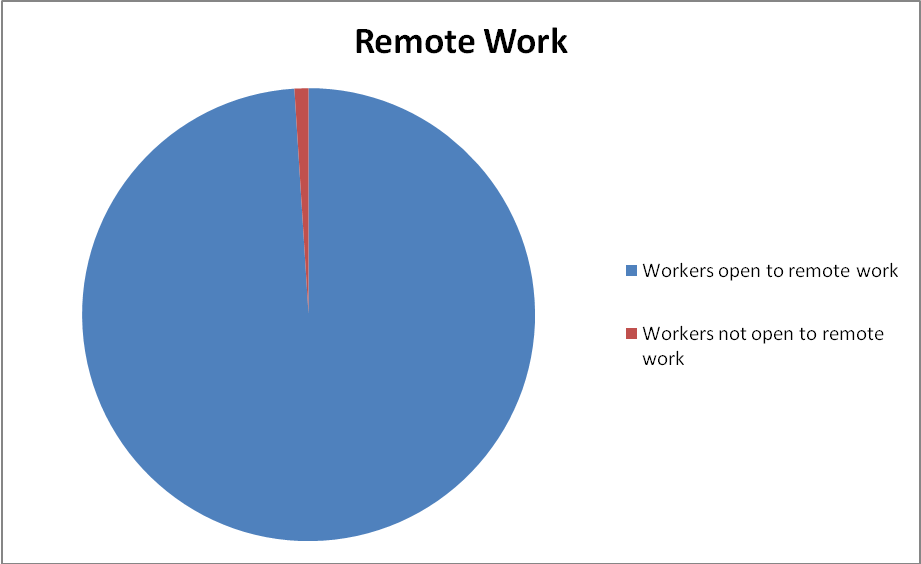
Are you curious about the state remote work in 2021?
As you might be aware, remote wokers have grown over 44% in the last 5 years with as many as 7 million people already working remotely in the US.
Remote work has become a prominent feature in the recruitment scene for the past few years. There was an even greater spike in demand for and/or discourses about it due to the COVID-19 global pandemic.
One recurring question being asked by both employers and employees alike is how the pandemic affects the workspace and what would be the future of working in the post-pandemic world? Would it revert to the old guard? Or would more businesses stick to the pandemic-induced adoption of teleworking?
In light of these analyses, it is important that you are made aware of some key statistics about remote work.
Also, since remote work was already adapted by some before the pandemic started, differentiating between the pre-COVID-19 and post-COVID-19
- As of early 2020 in the US, before the pandemic, about 7 million people were already working remotely. That’s 3.4 percent of the population.
- 43 percent of U.S. employees were, to a reasonable extent, already partly working remotely.
- Remote working has grown by 44% over the last five years, and by 154% over last decade.
- Worldwide, 68% of workers worked from home at least once a month according to owl labs.
- 18% of workers around the world work remotely full-time before the pandemic.
According to Owl Labs, the job type and level you occupy greatly influence your ability to work remotely. For instance, newly recruited workers tend to work remotely the least, while C-suite members and VPs are the highest demography of remote workers.
- 13% of company directors reported working from home.
- 18% of executives work remotely more than on-site.
- 30% of those report working for a company that's fully remote.
- 32% of team managers work from home.
- 35% of remote workers are individual contributors.
- 46% of Founder/C-suite members work remotely at least part-time.
- 55% of VP-level employees remotely at least part-time.
New employees might work remotely less often at their company. Roughly 75% more on-site workers have worked in their positions for less than a year.
As said earlier, the adoption of remote work has been on the steady rise. Below is an overview of the increase:
- From 2010 till now, the number of people who work remotely at least once a week has risen by 400%.
- 42% of employees with the option of working remotely plan to do so for the next five years.
- Telecommuting increased by 22% between 2017 and 2018.
- 99% of respondents to Buffer’s survey on remote work opined that would love to work remotely, at least part-time, for the rest of their careers.

Employees are welcoming of the idea of working from home, as it not only decreases their chances of getting infected with the novel coronavirus, it also allows them more flexibility.
In fact, Amerisleep conducted a study of 1,001 remote workers and found that not only do they get better rest; their job satisfaction rating is 57% more than that of the average on-site worker.
- About 80% of the interviewees affirmed that their typical stress level during while working remotely was either “not stressed” or only “moderately stressed.”
- 77% of employees responded that they are more productive when working remotely, according to CoSo Cloud.
- A whopping 76% of remote workers prefer not going to their offices at all while working on a project to increase their attention span, an Atlassian survey revealed.
- The most preferred mode of communication by remote workers is email, while instant messaging and video chat follow.
- 84% of remote employees prefer to work from home, even though working remotely avails them the opportunity work from anywhere. This is why remote work is usually substituted with ‘working from home’.
- Interestingly, 23% of remote workers say they work longer hours than they would on-site.
- Also, 53% of remote workers say their chances of taking time off while working from is reduced when compared to their workplace per CoSo Cloud’s report.
- To further prove that remote work doesn’t equate lazing around, 43% of remote employees take three weeks or less of paid vacation per year in comparison to those who work from their company’s physical office, Buffer’s report finds.
- Finally, remote work doesn’t just benefit entry and midlevel workers. As a matter of fact, a survey done by Springer reveals that those with highly technical jobs are more productive when remote than in an office.
Although there are more arguments that support the adaptation of remote work, there are still some outliers. With more practice and fine-tuning, these downsides can be minimized.
- Furthering on the issue of isolation employees tend to feel when working from home, a Coso Cloud survey discovered that more than half of remote employees say they feel disconnected from other in-office employees.
- Contrary to the belief that work-life balance is guaranteed while working remotely. Buffer collated that this is not always guaranteed. About 22% of remote employees said that loosening up after a streak of work is their biggest challenge.
- Another 19% of remote employees listed loneliness as their biggest challenge.
- Given that about 4 billion worldwide do not have access to the internet, this constitutes the biggest problem to global scale adoption of remote work.
- Add the above to the fact that for the non-skilled workers, whose duties require them to be in-office at all times working remotely is near impossible.
Finally, before implementing the work-from-home model, it is important that employers and employees both deliberate on the positives and negatives, and find a balance that works for everyone. If you need to read on remote work, check out this blog post.
Frequently asked questions about remote work
1. What percentage of employees work remotely?
Across boards, 57% of employees work remotely. This is up from 39%.
2. Why is it important to gain remote skills in 2021?
Remote work is steadily increasing due to the advent of automation. This plus the COVID-19 pandemic has highlighted the need for flexible work conditions for workers.
3. Is remote work becoming more common?
Yes, more companies are buying into the idea of remote work. In fact, over 70% of workers reported working remotely from time to time.
4. Do companies save money from remote work?
Both the company and the employee can save money from remote work, as cost of commuting and employee logistics expense would be eliminated while working from home.
5. Is it working remote or working remotely?
Remote work implies that the employee is remotely located; while working remotely may denote something temporal. For example, Ms. B is a remote worker tells a different story from Ms. B is working remotely (could be because she is ill or any time-dependent reason.
Also read: countries with the highest youth unemployment rate.
Sources:
Owl Labs
Buffer
GetApp
FlexJobs
Atlassian
CoSo Cloud

Staff Writer
This article was written and edited by a staff writer.


Leave a Comment